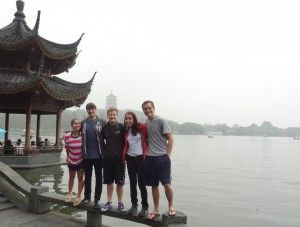With the end of the Year of the Dragon comes increased environmental uncertainty for the People’s Republic of China.
Air quality in China has been a growing concern worldwide, as a January 12 study by the Environmental Protection Agency shows air pollution in Beijing ranking a staggering 744 on a 1-500 scale.
This is especially significant to those involved in Pepperdine’s study abroad program located in Shanghai, a city whose air quality was deemed “unhealthy” by the local U.S. consulate.
According to the Environmental Performance Index collected by Yale University, China ranked 128 out of 132 countries in terms of air quality — a result of rapid industrialization and dependence on diesel and coal.

(Courtesy of Mitch Bennett)
Smog is a constant problem in Shanghai, according to Mitch Bennett, RA for Pepperdine’s Shanghai program.
“The air quality varies from day to day,” Bennett wrote in an email. “Most days the sky is just overcast but occasionally a thick smog can be seen around campus.”
Originally from Denver, Bennett said the effects of pollution impact everyday life.
“We can all feel it in our breathing,” Bennett wrote. “We take shorter breaths. Every now and then, someone develops a bad cough that can result in some nasty black mucus. Worst of all, is the pollution is so bad it affects the skin.”
Sophomore Allison Jackson, originally from rural Ohio, said that while the nearest major factory is almost 40 miles away, smog often prevents students from seeing stars at night.
“The pollution really affects you the first few days,” Jackson wrote in an email. “A good amount of us got pretty bad coughs. My skin tends to get grimy more easily as well. I tried to run in China, but I found that I couldn’t catch my breath very easily and often times I would run through clouds of smoke due to the large number of smokers.”
Freshman Tiffany Zhou said while she did notice the pollution in Shanghai during the three years she lived in the city, it should not intimidate those who want to visit.
“Pollution is real in Shanghai in a much larger way than in any other city I’ve ever visited,” Zhou said. “Air pollution is definitely a concern for anyone who lives in Shanghai, but I’d never let it deter me from ever living in such an amazing cultural and urban center.”
Zhou said she thinks the situation is blown out of proportion.
“Honestly, the freaky statistics are usually used as scare tactics to deter the unsuspecting tourist,” Zhou said. “Yes, there is a lot of smog, and yes, in some areas of the city, if you are outside for too long, it can hurt to breathe. But I’ve never been deterred from living a normal life and experiencing all that Shanghai has to offer just because the trucks still use diesel.”
One of the most hazardous aspects of pollution in China is the concentration of particles in the air that are smaller than 2.5 micrometers, which is on average 10 times higher in Beijing than in New York, according the Atlantic. At this size, particles can penetrate the lungs and enter the bloodstream.
Because Shanghai is located on the coast, many claim it experiences less air pollution than Beijing to the North.
Student Communication Coordinator Kali Jelen agreed that while pollution levels in Shanghai are noticeably worse than Malibu, it is not nearly as bad as cities like Beijing.
“The air pollution in Shanghai is not nearly as bad as some other industrial cities in China,” Jelen wrote in an email. “I felt that both Beijing and Xi’an were much, much worse. After a day of touring outside, I could feel the silt and sand in my pores and on my hair. Everything just felt dirty.”
Students can take steps to protect themselves.
“There are measures you can take to reduce your health risk,” Bennett wrote. “First of all, stay informed. You can gain up to date information from the U.S. consulate in Shanghai and their website. Second, avoid exercise or heavy exertion outside that would cause your lungs to work harder. Third, for any students with asthma or other lung conditions, take your medication regularly.”
———————————————————————————————————————
Follow the Pepperdine Graphic on Twitter: @PeppGraphic
Follow Nate Barton on Twitter: @TheNateBarton

